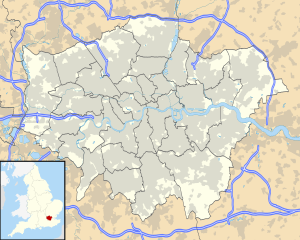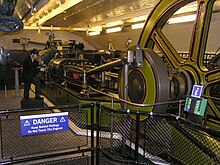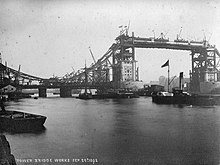Tower bridge
Coordinates: 51 ° 30 ′ 20 " N , 0 ° 4 ′ 32" W.
| Tower bridge | ||
|---|---|---|
| The bridge east of the south bank | ||
| use | Motor vehicles, pedestrians, bicycles | |
| Crossing of | Thames | |
| place | London | |
| Entertained by | Bridge House Estates | |
| construction | Chain bridge , bascule bridge | |
| overall length | 244 m | |
| Longest span | 61 m | |
| Arrow height | 65 m | |
| height | Lane 9 m, pedestrian bridge 43 m | |
| vehicles per day | 40,000 vehicles and pedestrians daily | |
| start of building | June 21, 1886 | |
| opening | June 30, 1894 | |
| planner | Horace Jones | |
| location | ||
|
|
||
| Construction drawing of the Tower Bridge | ||
The Tower Bridge is a road bridge over the River Thames in London and named after the nearby Tower of London . It was opened in 1894 and connects the borough of Tower Hamlets on the north side with the borough of Southwark in the London Borough of Southwark on the south side. The main road A 100 leads over the bridge. Tower Bridge is a bascule bridge built in the neo-Gothic style and the most easterly Thames bridge in London. The Tower of London and St Katharine Docks are on the north bank and City Hall on the south bank . The bridge is owned by Bridge House Estates , a City of London Corporation charity that is also responsible for its maintenance. Occasionally Tower Bridge is confused with London Bridge , but this is the next bridge upstream. To the east of the Thames, downriver there is only the Queen Elizabeth II Bridge - only since 1991 .
Building
As a combined suspension and bascule bridge, Tower Bridge is 244 meters long, the height of the two bridge towers is 65 meters. The roadway between the towers, which are 61 meters apart, is nine meters above the River Thames. Two footbridges for pedestrians run between the two towers at a height of 43 meters above the water. The pedestrian walkways clamp the towers together at the top and transmit the horizontal tensile forces of the suspension bridge rope pairs. The two movable structural parts (baskules) can be folded up to an angle of 86 degrees to allow large ships to pass through.
The opening and closing of the baskets is done by a hydraulic system - originally based on water pressure. With the help of two piston steam engines from WG Armstrong Mitchell & Company (360 PS ), water was pumped into large pressure accumulators, the so-called accumulators , under a pressure of 50 bar (750 psi ) . The power that can be called up was converted into mechanical work so efficiently that the lanes could be folded up in two minutes - a technical masterpiece of the late 19th century.
From 1942 until the end of World War II, there was a third hydraulic Vickers machine with an output of 150 hp in the machine house . It would have been used if an aerial bomb had damaged the other two machines. In 1974 the hydraulic system was changed from water to oil hydraulics, which works with electrically driven pumps; the old machine house with the decommissioned steam engines can still be visited. 1,977 of were to celebrate silver jubilee of Elizabeth II. The metal parts of the Tower Bridge red in British national colors, white and blue painted; this color scheme has remained to this day.
The upper bridges for the pedestrian connection are immobile. You can therefore cross the river on foot with the bridge raised - but at the price of using the stairs in the towers with a height difference of 34 m to the road bridge. The pedestrian walkways high above the water house a bridge museum, in which the construction and history of the bridge are presented in pictures and models.
traffic
The Tower Bridge baskets are only opened as far as is necessary for the passage of the respective ship. The full opening (86 °) is now only required for large cruise ships. In the urban area, the Thames is essentially only used for tourism. The bridge is therefore folded up less and less frequently (around 1000 times a year). However, shipping still has priority over road traffic. The numerous excursion boats that operate on the Thames are small enough to pass under the carriageway even when the bridge is closed.
In exceptional cases the bridge is also fully opened for smaller ships: This is done for ceremonial reasons and is considered a very special honor. This was the case for Sir Winston Churchill's funeral procession in 1965, when Francis Chichester returned after his one-handed circumnavigation in 1967, and during the parade on the Thames to mark the 60th anniversary of Queen Elizabeth II's throne on June 3, 2012.
The bridge forms part of the inner ring road of London and is used by around 40,000 vehicles every day. It is also the eastern boundary of the congestion charge zone, but driving on the bridge itself is not subject to tolls. To preserve the integrity of the historic structure, the City of London Corporation has imposed a speed limit of 20 mph (32 km / h) which is monitored by cameras.
history

In the second half of the 19th century, the steadily increasing traffic in the port areas in the East End made it necessary to build a river crossing east of London Bridge. A traditional fixed bridge was out of the question because otherwise the access to the then still existing port facilities close to the city between London Bridge and the Tower of London would have been cut off. That is why a tube, the Tower Subway , was built under the river in 1870 . After a short period of operation, this served as an underground tube, but then only as a tunnel for pedestrians.
In 1876 a committee was formed to look for a solution to the traffic problems. It held a public competition. Over 50 projects were submitted, including one by Joseph Bazalgette . Examination of the proposals dragged on for years, and it was not until 1884 that the proposal was approved by Horace Jones , the City of London architect (who was also a member of the jury).
Construction work began with the laying of the foundation stone on June 21, 1886; five construction companies and 432 workers were busy building the bridge. In order to support the huge structure, two huge piers weighing 70,000 tons had to be sunk in the river bed. More than 11,000 tons of steel were required for the towers and the pedestrian bridges. The towers were clad with Portland limestone to protect the steel underneath on the one hand and to give the bridge a more pleasing appearance on the other.
Horace Jones died in 1887, and responsibility passed to his chief engineer, John Wolfe-Barry . The official opening took place on June 30, 1894 by the then Prince of Wales (later King Edward VII ) and his wife Alexandra of Denmark .
The pedestrian bridges soon had a reputation for attracting prostitutes and pickpockets and were closed in 1910. Most of the time, pedestrians preferred to wait on the bank and watch the baskets pull up and the ships going by. In 1982 the pedestrian bridges were opened to the public again; today they serve as a museum and lookout point.
On April 5, 1968, Flight Lieutenant Alan Pollock took the opportunity on a routine flight to the West Raynham military airfield in Norfolk for an unauthorized demonstration over London: With his Hawker Hunter FGA. 9 (XF442) he circled the British Parliament building three times, saluted with the typical "wing rocker" above the Royal Air Force Memorial and flew through London's Tower Bridge between the upper pedestrian and lower folding walkways. With this action, four days after the 50th anniversary of its founding, he wanted to demonstrate the efficiency of the Royal Air Force and at the same time protest against the government under Prime Minister Harold Wilson.
In 2014, a pedestrian bridge was given an area with a glass floor, from which you can look down 42 meters.
The bridge connects the boroughs of Southwark on the south bank, on the left, and Tower Hamlets and the City of London on the north bank.
Replicas
A partial replica of the Tower Bridge is in Suzhou (Jiangsu) , China . 31 ° 22 ′ 24 ″ N , 120 ° 36 ′ 42 ″ E It is 9145 km away from its prototype and has no lifting mechanism, but four towers that are open to walkways.
Web links
- Tower Bridge website with a subpage about current ship transits
- Technical article on the construction of the bridge
- Tower bridge. In: Structurae
- The Tower Bridge as a 3D model in SketchUp's 3D warehouse
Individual evidence
- ^ Bridge History. Tower Bridge, accessed May 27, 2018 .
- ^ Hawker Hunter History . In: thunder-and-lightnings.co.uk , accessed May 27, 2018.
- ↑ Passer-by drops bottle: Tower Bridge's glass floor shattered . In: spiegel.de , accessed on May 27, 2018.
- ↑ From Tower Bridge to Sydney Harbor, welcome to China's city of clones . In: The Guardian , June 3, 2014. Retrieved July 14, 2015.
- ↑ China's Fake Cities , ProSieben - Galileo , episode 33, season 2015 from February 2, 2015 (YouTube)
|
Upstream Tower Subway |
River crossings of the Thames |
downstream Thames Tunnel |














